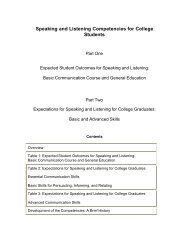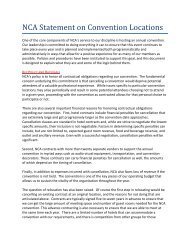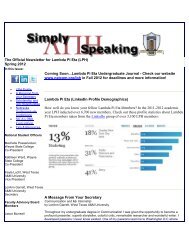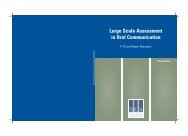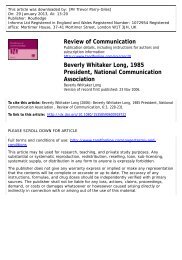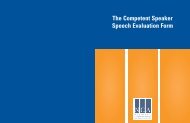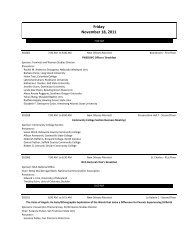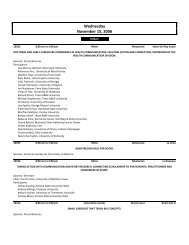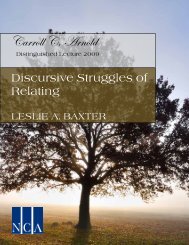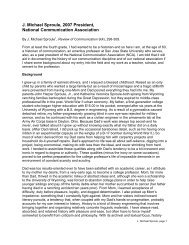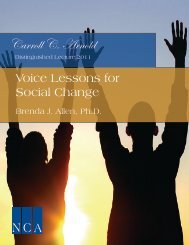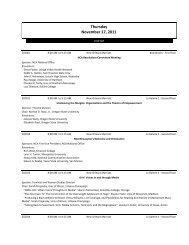Assessing Motivation to Communicate - National Communication ...
Assessing Motivation to Communicate - National Communication ...
Assessing Motivation to Communicate - National Communication ...
- No tags were found...
You also want an ePaper? Increase the reach of your titles
YUMPU automatically turns print PDFs into web optimized ePapers that Google loves.
The nature and assumptions underlying the Willingness<strong>to</strong> <strong>Communicate</strong> (WTC) scale are outlined and discussed.Data are discussed which relate <strong>to</strong> the reliabilityand validity of the instrument. It is concluded that thescale is of sufficient quality <strong>to</strong> be recommended for researchand screening purposes.Kearne, P. & Waldeck, J., (2001). Teacher e-mail messagesstrategies and students’ willingness <strong>to</strong> communicateonline. Journal of Applied <strong>Communication</strong>Research, 29(1), 54.In light of the prevalent use of e-mail between teachersand students, researchers have highlighted the need <strong>to</strong>assess its uses and effects. Relying on the research andthinking of teacher immediacy and extra-class communication,we developed a scale that measures those e-mailmessage strategies that influence student’s willingness <strong>to</strong>communicate online with their teachers. Next, we isolatedthose reasons that students use e-mail <strong>to</strong> interactwith their teachers: (1) <strong>to</strong> clarify course material and procedures,(2) as a means of efficient communication, and(3) for personal/social reasons. Finally, we examined studentcharacteristics such as gender and ethnicity, and his<strong>to</strong>ryof e-mail use that may (or may not) influence theirattitudes <strong>to</strong>ward e-mail exchanges with teachers.Olaniran, B.& Roach, D. (2001). Intercultural willingness<strong>to</strong> communicate and communication anxiety ininternational teaching assistants. <strong>Communication</strong> ResearchReports, 18(1), 26-35.This study addressed patterns and correlates of communicationapprehension, intercultural communicationapprehension, and intercultural willingness <strong>to</strong> communicatein international teaching assistants. Results indicatedan inverse relationship between communicationapprehension of international TAs and their satisfactionwith students, relationship with students, and perceptionsof” student ratings of instruction. Similar resultswere found for ITA state anxiety. Inverse relationshipswere also found between ITA intercultural communicationapprehension and relationship with students andperceptions of student ratings of instruction. Internationalteaching assistant CA and ICA were positivelyrelated with ITA state anxiety.Miller, J., & Morgan, S. (2002). Beyond the organ donorcard: The effect of knowledge, attitudes, and valueson willingness <strong>to</strong> communicate about organ donation<strong>to</strong> family members. Health <strong>Communication</strong>, 14(1),121-134.Although numerous studies have examined many ofthe predic<strong>to</strong>rs of signing an organ donor card, includingknowledge, attitudes, values, and demographic variables,very few have examined the fac<strong>to</strong>rs associatedwith individuals’ willingness <strong>to</strong> communicate abou<strong>to</strong>rgan donation with family members. Because organdonation does not take place without the permission ofa person’s next-of-kin, government agencies and organprocurement organizations have targeted communicationwith family members as a primary objective of organdonation campaigns. This study reports the resultsof a survey of a stratified random sample of adults at 2local sites of a national employer. Results indicate thatknowledge, attitude, and altruism are significantly related<strong>to</strong> 2 measures of willingness <strong>to</strong> communicate: pastbehavior (whether respondents had already discussedorgan donation with family members) and a scale measuringwillingness <strong>to</strong> communicate about organ donationin the future. Because the quality of discussionsbetween the potential donor and his or her family willdepend on how well the donor is able <strong>to</strong> address vital issuesregarding donation, it is concluded that campaignsseeking <strong>to</strong> promote communication between familymembers about organ donation must simultaneouslyseek <strong>to</strong> increase knowledge, debunk myths, and bolsterpositive attitudes about donation.Yahima, T. (2002). Willingness <strong>to</strong> communicate in asecond language: The Japanese EFL context. ModernLanguage Journal, 86(1), 54.Willingness <strong>to</strong> communicate (WTC) is emerging asa concept <strong>to</strong> account for individuals’ first language (L1)and second language (L2) communication. This studyexamined relations among L2 learning and L2 communicationvariables in Japanese English as a foreign languagecontext using the WTC model and the socioeducationalmodel as a framework. A L2 communicationmodel was constructed and tested using AMOS version4.0, with a sample of 297 Japanese university students.In the model, a latent variable, international posture,was hypothesized <strong>to</strong> capture the general attitude <strong>to</strong>wardthe international community and foreign languagelearning in Japan. From structural equation modeling, itappeared that international posture influences motivation,which, in turn, influences proficiency in English.<strong>Motivation</strong> affected self-confidence in L2 communicationwhich led <strong>to</strong> willingness <strong>to</strong> communicate in a L2.In addition <strong>to</strong> this indirect path, a direct path from internationalposture <strong>to</strong> WTC in a L2 was significant. Themodel’s fitness <strong>to</strong> data was good, which indicates the20 <strong>Assessing</strong> <strong>Motivation</strong> <strong>to</strong> <strong>Communicate</strong>




